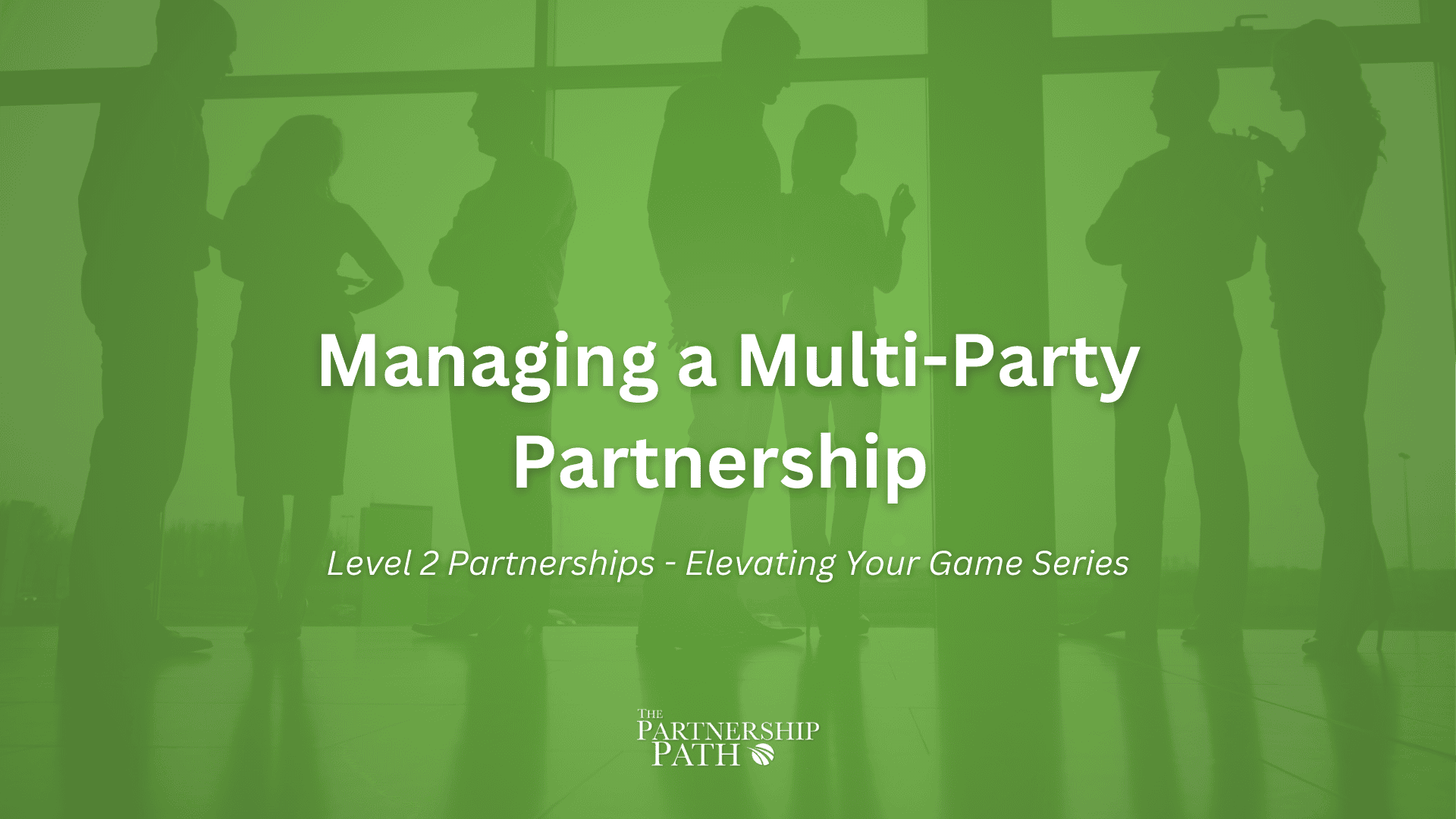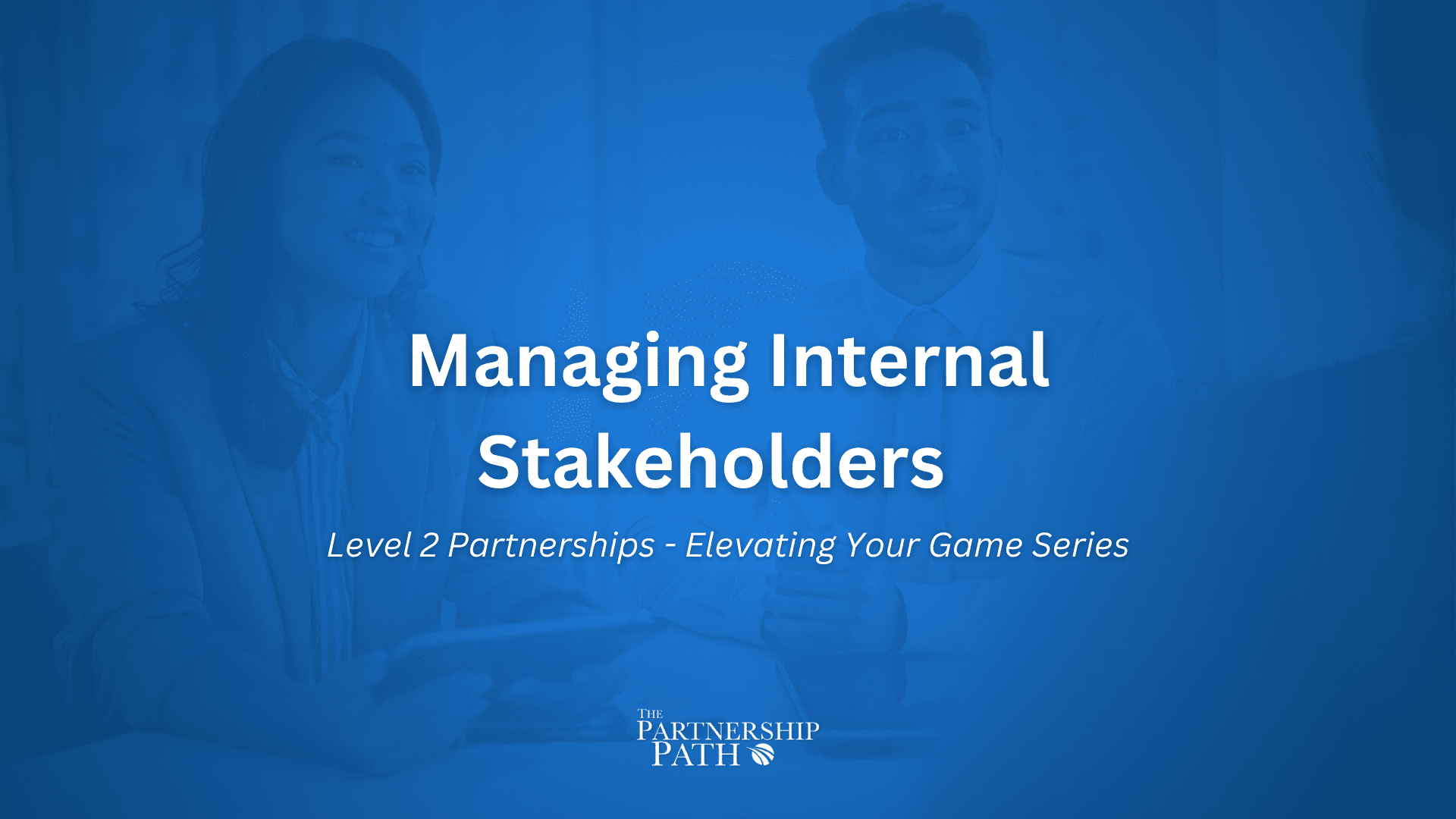Main Episode
IRL Episodes
Managing a Multi-Party Partnership
Welcome to the ultimate wrap-up of “Elevate Your Game: Advanced Partnering Skills of “The Partnership Path”, where John Rudow and Toni Kent don’t just talk about partnerships—they dissect the realities of today’s channel ecosystem. If you’ve ever tried to get more than two companies to move in the same direction, you know it feels a lot like herding cats.
Why share this? Because the old one-to-one partner formula is dead—real growth now comes from orchestrating multi-party partnerships (MPPs) that cut across solutions, roles, and markets. This episode is for anyone ready to get serious (and strategic) about navigating these complex, advanced alliances.
Transcript
John (00:01)
Well, hello again, Toni, and welcome to our last episode of Season 3, Elevate Your Game, Advanced Partnering Skills of the Partnership Path. I can’t believe we’re already at the end of Season 3. It’s crazy.
Toni (00:03)
Thank
Wow.
It is, and it has been advanced, John. That’s what I think. think these have been bigger, trickier, more thought provoking concepts. Yeah. Content. Yeah. That’s good. Yeah.
John (00:28)
Yeah, that was our intent of this season was to tackle some
of those harder topics that I think people are dealing with every day, but nobody ever talks about in this kind of a forum. So it has been challenging, but really, really good. We’ve gotten really good feedback from the community on a lot of these. So as is evidenced by our in real life episodes. So yeah, so we’re going to wrap season three with this topic of multi-party partnerships.
Toni (00:37)
Mm-hmm.
Yeah, it’s true.
Mm.
Yes, MPP.
John (01:00)
MPP, yeah. And look, I think this is super relevant in today’s world. you’re paying attention in the partnership world, if you’re watching like, you know, Jay McBain’s commentary and some of that kind of stuff, everybody’s talking about the fact that there is an ecosystem of partners, right? It’s not this one-to-one relationship like it used to be. is, there are a lot more of these multi-party.
Toni (01:17)
Yes.
John (01:27)
partnerships that we need to be thinking about and so I wanted to spend some time talking about that. But before I do, want to come back to a topic you mentioned. I can’t remember if it was in one of our episodes or if it was actually in a prep conversation we had. There’s a term that Microsoft uses and some of the other hyperscalers and large partners uses, which is P2P, the letter P, the number two, the letter P, right? P2P plays.
Toni (01:51)
Yeah.
Hmm.
John (01:56)
And I just want to talk a little bit about what, like when you’ve heard that or when you use that, what do you mean by that? What does that look like? And then let’s talk about how that might fit with multi-party partnership.
Toni (02:08)
Yeah, sure. mean, it’s sort of base level. was the idea of being a partnership broker, if you like. So helping, let’s say, what could be an ISV to partner with a reseller. So that’s how, I mean, I could go on to describe different partner types, but ultimately it was saying we will help broker a relationship.
John (02:17)
Yeah, yeah.
Toni (02:36)
based on us looking across the ecosystem and saying who might fit together.
John (02:41)
Yeah.
Yeah. Is it fair to say that in most of those P2Ps that you set up, that the vendor you were working for at the time was also a part of whatever the resulting partnership was?
Toni (02:58)
⁓ no, I think it was kind of seen as it is dating stuff. Like you do the introduction, but there might not have been an expectation that you would report back on the health of that partnership or the, you know, because it might be that the ISV partner was being measured on how, how many instances of Azure they lit up.
John (03:00)
Okay.
Right?
Toni (03:26)
or
John (03:26)
Yeah.
Toni (03:27)
these old terminology, but yeah, it wasn’t seen as something that you would, there might be like a target on what you to create 50 broker 50 partnerships, but are you going to be measured on what the productivity of that partnership is? Potentially not.
John (03:37)
Yeah. Yeah.
Yeah, and see, so this is where I think, this is where I think multi-party partnership does come in. And this is where I think the kind of traditional thought process around P2P starts to break down, which is in the scenario you just described, you even said, right, the one of those partners is still trying to create Azure spins for using the Microsoft example, right? And so Microsoft actually is
Toni (03:53)
Mm.
Mm.
John (04:16)
a part of that partnership, right? But we don’t think of it that way. And what I would argue is we probably need to think of it that way. Like the reality is, is that the reason we’re doing a P2P is that one of our partners has identified a market opportunity that they want to go after for their business, but it’s still part of our partnership because they’re going after it with our combined solution.
Toni (04:17)
Yeah.
Hmm.
Mm.
John (04:46)
But they
need another party to do something, whether that’s a complementary solution or it’s a services function or it’s a resell function or whatever it is, right? And I think where we kind of missed the ball is we should be thinking about that new thing as a partnership. It just happens to have three members of it. It’s the ISV, the reseller and Microsoft.
Toni (04:49)
Yeah.
Mm-hmm.
Yeah.
John (05:16)
And then everything we’ve talked about in this podcast from the very beginning applies to that partnership. We should have a strategic alignment for that three-party partnership going to market. We should have a tactical alignment. We should have goals. We should have measurements. All that stuff still applies. But I think for some reason we have a tendency to, I think you said it was, you know, we put the two together and then say, bye-bye, you know, good luck.
Toni (05:34)
Mm.
Yeah,
have a lovely time! Yeah, yeah.
John (05:47)
Yeah, I hope it works
out for you. And yet, like, I think we need to be more pragmatic about that, especially in this world today where one-on-one partnerships are becoming more and more rare. Every way we go to market is involving multiple partners. And so we should probably be a little bit more disciplined about that and think about how do we get the most out of that?
Toni (06:12)
Yeah. I think, ⁓ so something for a very current example is, ⁓ and I can talk about this because it’s public domain. So you’ve got, ⁓ a distributor, ⁓ TD CINIX who are running an AI ecosystem and inviting lots of partners to participate in that. And they are doing it multi-vendor. So they just running an event with NetApp.
IBM and Lenovo. And so they’re bringing together, I mean, if you want multi partner party partnership, but when you’ve got things like AI, this is cutting across so many different areas. You can’t just go throw them in a room and yeah, this is some really strategic thinking about how it touches all those different areas.
John (06:48)
That’s right. That’s right.
That’s right. Yeah.
Yeah, look, and if we go back to some of our earlier conversations and talk about like, why do partnerships fail? Right? They fail primarily if we just think about a two-party partnership. The reason they fail is because the two organizations never really came together and said, this is what we’re going to do together. And I’m committed to that and I’m going to invest resources in
Toni (07:19)
Hmm.
Mm.
Hmm.
John (07:38)
The
best partnerships are the ones where that happens, right? They agree, hey, here’s what we’re gonna go after. Here’s the boundaries. Here’s how we’re gonna go after it. Here’s how much we’re gonna invest in it or whatever. This seven party partnership that you just described, it’s exactly the same. It will not be successful unless all seven parties actually agree this is what we’re going after. I’m committed to that and I’m gonna invest
Toni (07:41)
Yeah.
Yeah.
Yeah.
Yeah.
John (08:08)
commensurately, commensurately into that, right? And so that means that someone has to take ownership and say, hey, let’s be disciplined about this. Because if those seven parties come together like a normal partnership that doesn’t have a plan, they’re each in there for their own agenda. They’re only going to invest until they don’t get what they want. And
Toni (08:09)
Yes.
Hmm.
Yeah.
John (08:36)
I mean, it’s chaos. It’s just the only ones that are successful in that mode are the ones that are, you know, pure luck. And so it requires, it’s hard, it’s way harder to put together a strategic alignment for three partners than it is two. And it’s even way harder to do that for seven, but it’s the only way it’ll be successful is if everyone understands,
Toni (08:39)
Yeah.
Yeah.
Hmm.
John (09:05)
This is the direction we’re going. This is what we want to do. This is how we’re defining the customer that we’re going after. This is how we’re defining the solution that we’re going after. And they go after it together. Now, here’s what’s really interesting about what you said. You mentioned TD Cynics. Distributors are the ones who can actually do this. They’re the ones who can bring all those parties together.
Toni (09:18)
Yeah.
Yes.
Hmm.
John (09:35)
and then be the ones to manage and kind of put the framework around that. It would be much harder for any one of those other players to be the one to do that simply because of who they are. And the distributor already is in that role of the aggregator, the bringer together of solutions. And so there’s a lot of really good potential there.
Toni (09:38)
Hmm.
Yeah. Yeah. Yeah. Yeah.
Yeah.
Yeah.
Yeah.
John (10:02)
when a distributor or an aggregator is involved.
Toni (10:06)
Yeah, that’s why, let’s see, but you know, I would love to have someone from distribution to share their kind of thoughts on that in an in real life episode. Yeah, but that is it’s a lot of plates that you’re spinning at the same time.
John (10:16)
Yeah.
That would be very cool.
Yeah.
I mean, talk about herding cats, right? mean, it’s super difficult, but man, the partner team that can figure out how to do that well will see massive returns on those partnerships. Because when you can get seven providers aiming at the same target, I mean, that’s pretty powerful, right?
Toni (10:31)
Yeah.
Yeah.
Yeah.
Hmm.
Yeah.
John (10:53)
it’s going
to be hard for customers to say no to that.
Toni (10:56)
Yeah and I do think it
John (10:58)
Because odds are
one of those seven is a trusted advisor with that customer.
Toni (11:04)
Exactly. I think there is that, it’s like if you’re serious about doing it well, and if you’re serious about bringing something meaningful to the market, then it’s worth investing properly in those multi-party partnerships. To be across all of those things, it is if you want to be successful, and I guess maybe that is the difference, you know.
John (11:22)
And it’s hard to say. Yeah.
Toni (11:34)
⁓ if you don’t want to just rely on what they used to call it blue, a bluebird coming in, you know, some big deal that you had no visibility of, ⁓ for the long-term success is you need to be focused and be serious about these things.
John (11:39)
That’s right, that’s Yeah. Yeah.
Yeah. Yeah. I mean, look, the danger of not doing it is that there will be, if we use your example, these seven vendors, the danger is there will be several of those seven who are going to essentially take advantage of that partnership to get leads that they’re going to follow up on on their own or to, you know, get access to a customer database that they didn’t have access to before or whatever. And the only way to
to make sure that everyone plays fair is to actually manage it like a partnership and really put it together with an agreement and a set of goals and really get laser focused on what we’re doing. I can’t wait to hear what someone in the community or multiple people in the community have to say about this. I think this is a really, really difficult but highly relevant topic today.
Toni (12:48)
Yeah.
John (12:48)
How do we manage
these multi-party partnerships and how do we scale what we’ve been doing with just one partner at a time into five, six, seven partners at once?
Toni (13:01)
Yeah,
advanced level stuff, John. Yeah.
John (13:05)
Hey, that’s what we’re here for. Well,
thanks again for season three, Toni. It’s been a lot of fun and stay tuned for season four.
Toni (13:12)
Yeah, thanks to you, John. Bye bye.
John (13:15)
Bye.
Key Takeaways
- Multi-party partnerships are the new standard. Simple P2P matchmaking isn’t enough; real impact comes from orchestrating several partners aligned to a common vision.
- Discipline and structure drive success. Without clear strategic/tactical alignments, defined investments, and shared measurements, even the most promising alliances devolve into chaos.
- Distributors are the secret weapon. Aggregators like TD SYNNEX can facilitate, manage, and scale multi-vendor partnerships that would otherwise collapse under their own complexity.



